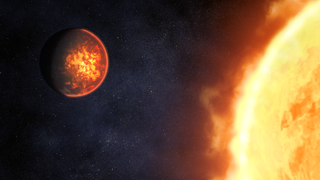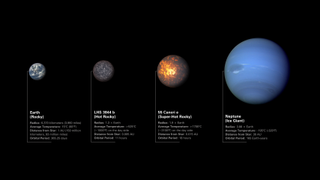James Webb Space Telescope will study two strange 'super-Earths'
Officials promise geology 'from 50 light-years away.'

The James Webb Space Telescope plans to explore strange, new rocky worlds in unprecedented detail.
The telescope's scientific consortium has an ambitious agenda to study geology on these small planets from "50 light-years away", they said in a statement Thursday (May 26). The work will be a big stretch for the new observatory, which should exit commissioning in a few weeks.
Rocky planets are more difficult to sight than gas giants in current telescope technology, due to the smaller planets' relative brightness next to a star, and their relatively tiny size. But Webb's powerful mirror and deep-space location should allow it to examine two planets slightly larger than Earth, known as "super-Earths."
Neither of these worlds is habitable as we know it, but investigating them could still be a proving ground for future in-depth studies of planets like our own. The two planets Webb officials highlighted include the super-hot, lava-covered 55 Cancri e, and LHS 3844 b, which lacks a substantial atmosphere.
Live updates: NASA's James Webb Space Telescope mission Related: How the James Webb Space Telescope works in pictures

55 Cancri e orbits its parent star at a tight 1.5 million miles (2.4 million km), about four percent of the relative distance between Mercury and the sun.
Circling its star only once every 18 hours, the planet has blast furnace surface temperatures above the melting point of most types of rocks. Scientists also assumed the planet is tidally locked to the star, meaning one side always faces the scorching sun, although observations from NASA's Spitzer Space Telescope suggest the hottest zone might be slightly offset.
Get the Space.com Newsletter
Breaking space news, the latest updates on rocket launches, skywatching events and more!
Scientists say the offset heat might be due to a thick atmosphere that can move heat around the planet, or because it rains lava at night in a process that removes heat from the atmosphere. (The nighttime lava also suggests a day-night cycle, which might be due to a 3:2 resonance, or three rotations for every two orbits, that we see on Mercury in our own solar system.)
Two teams will test these hypotheses: one led by research scientist Renyu Hu of NASA's Jet Propulsion Laboratory will examine the planet's thermal emission for signs of an atmosphere, while a second team led by Alexis Brandeker, an associate professor from Stockholm University, will measure heat emittance from the lit side of 55 Cancri e.
LHS 3844 b is also a close orbiter, moving around its parent star just once every 11 hours. The star, however, is smaller and cooler than that of 55 Cancri e. So the planet's surface is likely much cooler, and Spitzer observations have shown there is likely no substantial atmosphere present on the planet.
A team led by astronomer Laura Kreidberg at the Max Planck Institute for Astronomy hope to catch a signal of the surface using spectroscopy, in which different wavelengths of light suggest different elements. Thermal emission spectrums of the planet's daylight side will be compared to known rocks like basalt and granite to see if they can deduce a surface composition.
The two investigations "will give us fantastic new perspectives on Earth-like planets in general, helping us learn what the early Earth might have been like when it was hot like these planets are today," Kreidberg said in the same statement.
Webb is now working through latter-stage commissioning procedures like tracking targets in the solar system and moving between hotter and colder attitudes to test the strength of its mirror and instrument alignment. The $10 billion observatory should finish its commissioning around June or so and move into its Cycle 1 of observations shortly afterwards.
Follow Elizabeth Howell on Twitter @howellspace. Follow us on Twitter @Spacedotcom and on Facebook.
Join our Space Forums to keep talking space on the latest missions, night sky and more! And if you have a news tip, correction or comment, let us know at: community@space.com.

Elizabeth Howell (she/her), Ph.D., is a staff writer in the spaceflight channel since 2022 covering diversity, education and gaming as well. She was contributing writer for Space.com for 10 years before joining full-time. Elizabeth's reporting includes multiple exclusives with the White House and Office of the Vice-President of the United States, an exclusive conversation with aspiring space tourist (and NSYNC bassist) Lance Bass, speaking several times with the International Space Station, witnessing five human spaceflight launches on two continents, flying parabolic, working inside a spacesuit, and participating in a simulated Mars mission. Her latest book, "Why Am I Taller?", is co-written with astronaut Dave Williams. Elizabeth holds a Ph.D. and M.Sc. in Space Studies from the University of North Dakota, a Bachelor of Journalism from Canada's Carleton University and a Bachelor of History from Canada's Athabasca University. Elizabeth is also a post-secondary instructor in communications and science at several institutions since 2015; her experience includes developing and teaching an astronomy course at Canada's Algonquin College (with Indigenous content as well) to more than 1,000 students since 2020. Elizabeth first got interested in space after watching the movie Apollo 13 in 1996, and still wants to be an astronaut someday. Mastodon: https://qoto.org/@howellspace
